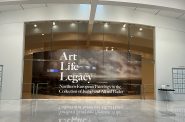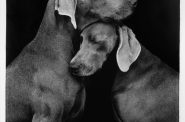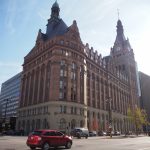Rembrandt first among treasures of Kenwood House
Rembrandt, Van Dyck and Gainsborough, in an epic Gilded Age collection from London.

Rembrandt van Rijn (Dutch, 1606–1669) Portrait of the artist, ca. 1665 Oil on canvas framed: 56 11/16 x 49 5/16 in. Kenwood House, English Heritage; Iveagh Bequest, 1927 TL2012.49.38
Rembrandt’s late self-portrait, now on view at the Milwaukee Art Museum, is my favorite portrait — self- or otherwise — of any painter from any time. Over the last quarter century, I’ve discussed it with my art students again and again, in the context of the long series of self-portraits Rembrandt painted over a lifetime.
Life is change. Art styles go in out and out of favor. Rembrandt pushed the boundaries of painting beyond the taste of wealthy Dutch merchants of the 17th century. One son lived, but three other children did not. A wife died too young. Humiliation and poverty crept into his life. Rembrandt turned inward and to his art.
In Portrait of the Artist, ca. 1665, one of the world’s most amazing painters opens his heart. He most likely painted it for himself. He wears his painting clothes and cap. He holds his palette, maulstick, and brushes. The colors are still his limited palette of soft white, ocher yellows, browns and black, with the ever-present red in the vest beneath his cloak.
He stares out to invite all the world to look him in the eye. If ever eyes were windows to the soul, they are Rembrandt’s eyes in this portrait.

Aelbert Cuyp (Dutch, 1620–1691) View of Dordecht, ca. 1655 Oil on canvas framed: 51 15/16 x 65 1/4 in. Kenwood House, English Heritage; Iveagh Bequest, 1927 TL2012.49.5
So real and solid he stands before us, telling us that life is only what you make of it. The person disappears, the work remains. Mere color on canvas, but more. The process, clearly laid out for us, is at odds with the fashion of 1665. But Rembrandt had no patron but himself to satisfy.
He begins with the dark colors in thinner layers and builds to the lighter, thicker paint. Is this a finished painting? Who knows? He merges drawing and painting. As solid as his figure appears, we see the underpainting, the lines describing a form. His painter’s palette is a translucent film of brown that leaves the arm of his cloak showing through. A hint of his right hand disappears into the cloak or into the darkened spaced near the bottom of the canvas. The two black arcs — cropped circles — on the light brown wall behind him — what are they? Or what were they going to be? We want to read them as symbols, but can only speculate. Without them, the composition, the design of the painting, would be imperfect.
Lighter values and thicker strokes of paint lead our eyes to the painting’s focal point, Rembrandt’s eyes. His gaze rivets ours. The strong light source hits the right side of his face, defining the volumes of his nose, cheeks, lips, chin and furrowed brow above the deeply shadowed eyes. Yet, up close we see brush strokes of impastoed paint, layered one over the other with the lightest white skipping across the surface of the darker marks below. The strokes of paint lead our eyes to his own dark eyes, and we see Rembrandt.
I have spent so much time thinking about this painting, studying it in images in books and slides projected in a lecture hall. I’ve seen it live, at last, as the heart of the Rembrandt, Van Dyck, Gainsborough: The Treasures of Kenwood House, London exhibition at the Milwaukee Art Museum. Rembrandt’s self-portrait hangs in its own alcove against deep red walls. A bench opposite invites viewers to spend time with him. By agreement, one gallery guard stands by this painting at all times. This exhibition would be a must even if no other paintings were in it (as in the case of Raphael’s La Donna Velata‘s visit to the Milwaukee Art Museum in 2010).

Thomas Gainsborough (English, 1727–1788) Mary, Countes Howe, ca. 1764 Oil on canvas framed: 105 1/8 x 71 1/8 in. Kenwood House, English Heritage; Iveagh Bequest, 1927 TL2012.49.13

Joshua Reynolds (British, 1723–1792) Mrs. Musters as Hebe, 1782 Oil on canvas framed: 96 7/8 x 60 13/16 in. Kenwood House, English Heritage; Iveagh Bequest, 1927 TL2012.49.32
But Kenwood House, currently undergoing a major renovation, has sent many other paintings never before exhibited in Milwaukee. A large photo of the early 17th century neoclassical mansion greets you at the entrance of the exhibition. The house was built in 1616, extensively remodeled in 1764-79, and purchased in 1925 by Edward Cecil Guinness (of Guinness brewing), the first Earl of Iveagh. Lord Iveagh, an avid art collector, never lived in Kenwood House; he bequeathed it to Great Britain in 1927, to house his collection and make it free to the public.
In the press preview last week, Susan Jenkins, English Heritage curator working on the renovation of Kenwood House museum and its vast art collection, spoke about Lord Iveagh’s decision to collect the best paintings from the 18th and 19th centuries. He competed with such wealthy Americans as Henry Clay Fricke (The Fricke Collection, NYC) and Andrew Mellon (National Gallery of Art).
Lord Iveagh was as keen on the British painters of his day as he was on the Old Masters. As the catalog states, “To Anglophile collectors of the Gilded Age, works by these British painters were as prized as today’s auction-record- breaking new old masters: Picasso, Pollock, and Van Gogh. In 1891, Isabella Steward Gardner (Gardner Museum) in Boston wrote that ‘everybody looks at nothing unless it is an English picture and you cannot buy them for love or money.’”
William Rudolph, MAM’s Curator of American Art and Decorative Arts, organized the show into national styles. As Rudolph explained, the hierarchy of painting subjects in the 17th and 18th centuries put history painting at the top, followed by portraits, then landscapes, with still life holding the lowest status.
The landscapes begin this exhibition and range from Francois Boucher’s fanciful depictions of flirty French peasants gathering cherries or exchanging produce outdoors to Dutch landscapes and seascapes. Aelbert Cuyp’s View of Dordrecht, ca. 1655, is a beautiful example. The sky fills two thirds of it. Billowing clouds move from right to left, gaining size as they darken overhead and turn the blue sky gray. The sunset, beyond the picture frame on the right, singes the sky pale orange near the horizon. A passing ship, sails billowing as they catch not only the wind but also the warm light of the setting sun, partly blocks the view of the buildings beyond. The masts of a closer, larger ship send a strong tangle of lines skyward. The masts and their vertical reflection in the water create a centered, vertical mass that runs straight up to meet the horizontal clouds and anchor sky to water. Seamen at work on boats on either side balance the composition.

Frans Hals (Dutch, ca. 1581-1666) Pieter van den Broecke, 1633 Oil on canvas 28 x 24 in. Kenwood House, English Heritage; Iveagh Bequest, 1927 TL2012.49.17
Jenkins said Lord Iveagh especially collected paintings of women, and she referred to a room full of them as the Lord’s “harem.” Thomas Gainsborough’s full-length portrait of Mary, Countess Howe, ca. 1764, stands 95 inches tall. She commands attention. As in the Rembrandt self-portrait, the face is the focal point. Gainsborough modeled it beautifully, yet solidly, and carefully described every detail. The painted surface of the face contrasts with the loose, almost gestural strokes that describe the shiny pink dress and delicate, transparent lace of her collared apron and fancy sleeves. She stands alone, one hand holding up the lacy apron, one foot daintily pointing out from under the full pink skirt. Behind her, dark, gray and purple clouds billow about her brightly lit bonnet and face. A darkened landscape contrasts and highlights her garments. Up close, the light gestures of the fabric of that dress and apron are mesmerizing.
Gainsborough painted his women as up-to-date society fashion plates. Joshua Reynolds portrayed them as allegorical figures or characters from myth or literature, with an idea toward making the portraits timeless. Thus does one Mrs. Musters become Hebe, the Greek goddess of youth and cup-bearer to the greater gods.
Anthony van Dyck, a Netherlander, spent the greater part of his career in England, at first under royal patronage. His portraiture veered away from the stiff and formal. His likenesses make the sitter seem alive, notably in the case of James Stuart, 1st Duke of Richmond and 4th Duke of Lennox. This informal portrait is one of many of James Stuart, a cousin and confident of King Charles I. Here James wears a voluminous white shirt and casually draped red cloth (fun to paint). He sits in a chair, a lance propped against the wall behind him and an arm stretched out to a lovely dog who stares up at him adoringly.
Stuart and the dog are beautifully painted, but the composition as a whole has an abstract beauty. Van Dyck divided the painting vertically into thirds, defined by the lighter brown wall on the right; a landscape of billowing dark clouds with orange and pink highlights over a darker landscape on the left; and a wildly painted drapery, patterned in warm browns and black, to hold the center. Off center at right, James Stuart’s voluminous red cloth continues the drapery pattern and veers off to the right in a strong diagonal. The sleek brown dog, his head highlighted against the red cloth, meets the brown drapery at the crown of his head, forming another diagonal off to the left. Two dark triangles, a deep shadow in the red cloth and a smaller one at Stuart’s jutting elbow, anchor the portrait. The composition takes our eye back and forth between the loving dog staring at James and Stuart staring calmly out at us.
Frans Hals’ Pieter van de Broecke, 1633, was the winner in the gallery of portraits of men. Pieter smiles out at us and draws us into his company and, I am sure, lively conversation. His seafarer’s ruddy complexion and wispy, unbrushed hair seem polar opposites of the starched white lace of his collar and sleeves.
The paintings I’ve noted are just the highlights of a wide-ranging exhibition of 63 works. It also comprises galleries given to children, genre scenes, landscapes and hunting and riding scenes. Do spend some time with Edwin Landseer’s large, striking Hawking in the Olden Time (1832). In this history painting depicting Medieval hunting party, the men and their mounts are in the background. The aggressive element involves a heron and a trained hunting hawk in an airborne death match, contorted into a single surrealistic shape that appears much closer — startlingly close — than anything else within Landseer’s broad horizon.
Rembrandt, Van Dyck and Gainsborough, The Treasures of Kenwood House, London, is on view at the Milwaukee Art Museum through Jan. 13. Catherine Sawinski, assistant curator of earlier European art, will give a talk on the show at 1:30 p.m. Tuesday, Oct. 16, at the museum.
The American Federation of Arts and English Heritage organized this exhibition. An indemnity from the Federal Council on the Arts and the Humanities, with additional funding from the Samuel H. Kress Foundation, supported it. In-kind support is provided by Barbara and Richard S. Lane. All photos courtesy of American Federation of Arts.
Lee Ann Garrison is director of the Design Research Institute and an associate professor of art at UWM.
Get more out of TCD. Learn all our tricks at our User Guide/FAQ page.
Art
-
Exhibit Tells Story of Vietnam War Resistors in the Military
 Mar 29th, 2024 by Bill Christofferson
Mar 29th, 2024 by Bill Christofferson
-
See Art Museum’s New Exhibit, ‘Portrait of the Collector’
 Sep 28th, 2023 by Sophie Bolich
Sep 28th, 2023 by Sophie Bolich
-
100 Years Of Memorable Photography
 Sep 18th, 2023 by Rose Balistreri
Sep 18th, 2023 by Rose Balistreri
















Terrific meaty piece! Please note that the exhibition was organized by the American Federation of Arts and English Heritage. Also, that the photos are all “courtesy American Federation of Arts.” Thanks!
Thanks for the info, Michaelyn. — Strini
[…] Milwaukee Art Museum: Rembrandt first among treasures of Kenwood House | ThirdCoast Digest. Tagged with: Milwaukee Art Museum, painting, Rembrandt, […]